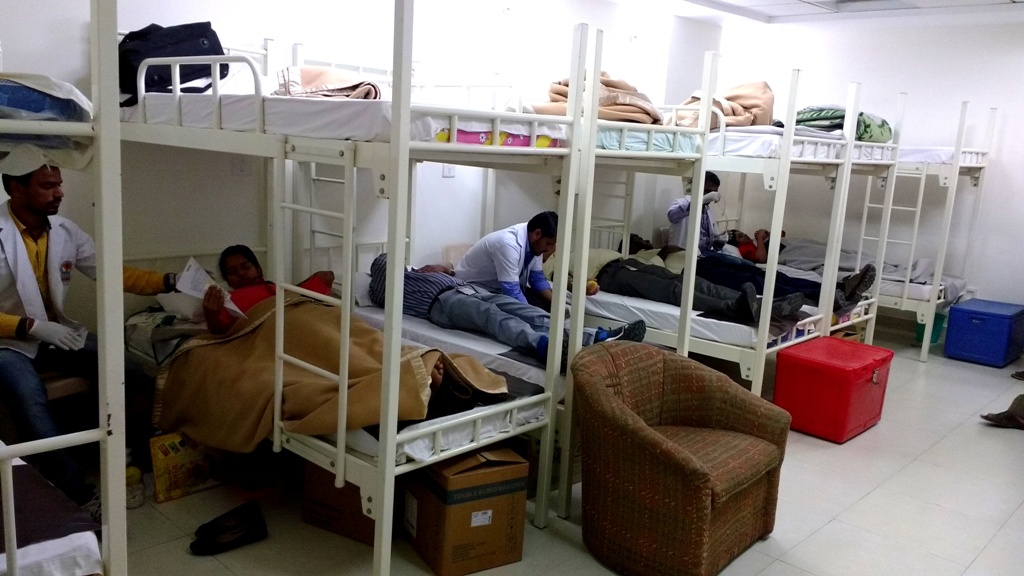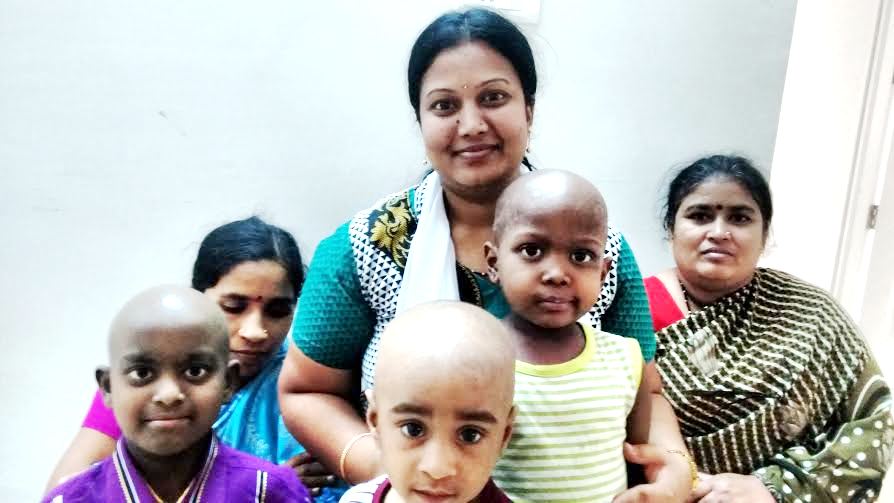Rakta Kranti - The blood revolution
Organizing blood donation drives in December has always been a challenge given the fact that most individuals, corporates, students are all on vacations or prefer to spend time at home with families in order to come back afresh for the upcoming new year. Unfortunately the Chennai floods had it’s impact on blood donation drives in Bangalore as well. Quite a few organizations wanted to focus on relief activities to reach out to people in Chennai and hence pushed plans for blood donation drives into February/March of 2016. Yet, we put together 12 blood donation drives collecting 913 units of blood. Surprisingly, the donor deferrals was just marginally over 10% and the noncompliance to agreed standards was at an all-time low of 1.0 per camp. This gives fresh impetus to the need to study if deferrals at blood donation drives are being done with a scientific temper or not – when the need for blood is more, the deferrals get reduced by more than half. The need for blood units also made the blood banks more compliant to protocols. The rate of adverse reactions went up by .5% above the average and stood at 3.7%.

Blood donation drives at 3 locations of Robert Bosch contributed 329 units of safe blood to the city. Good motivation was seen among employees and the teams had their hands full throughout the day in each of the drives. The year 2015 saw Robert Bosch organize as many as 9 blood donation drives making them one of the most reliable corporates for blood donation at this stage.
The second part of the annual series of blood donation drives at CGI was also held in the month of December. 323 units were collected in these drives. Again CGI has been an organization that has regularly stood up to promote voluntary blood donation with 6 blood donation drives every year where close to 1000 units of safe blood are pushed into the city. The commitment of the team is appreciable.
Blood donation drives at KPIT and AMD also materialized in a short time thanks to the good relationship built with the teams here. These are 2 organizations who always respond in crisis situations and are examples of how the intent to make a difference can be an example to overcome organizational difficulties. 88 units at KPIT and 74 units at AMD came as a big relief to the city while stocks were going low.
Making a small yet significant contribution to the city blood stocks were MTR Foods, Bank Bazaar, Concorde Apartments and Mahaveer Palace apartments. Blood donation drives at these locations saw a combined collection of 99 units. We thank the management at these organizations and apartment societies for their contribution.
The team also spent time visiting several malls, public utility departments with an intention to get more blood donation drives. The challenging period of low stocks and fewer blood donation drives has extended into January as well and is only expected to recover post Sankaranthi festivities.
Thalassemia Management and Care
The thalassemia day care centre at Indira Gandhi Institute of Child Health has a busy December with 303 patient visits and 394 units of blood transfused to the patients. Though blood was available, we still had a median duration of 8 days between collection and issue of blood - something which we prefer to keep below 5 days. As a consequence of several appointments from November, the pre-transplant hemoglobin was 8.3 gm/dl. The centre also saw some more enrolments taking the total number of children taking care to 297. Dr Madhura N S joined the center as a full time medical officer. This is expected to streamline and strengthen care and management significantly. The institute has also strengthened the daycare by providing Ms Mary as the permanent nursing staff. With a dedicated doctor, nurse, co-ordianator and also an additional technician at the blood bank the centre looks all st to strengthen the delivery of care for thalassemia.
Project Samrakha had a whooping 14 new registrations in the month of December taking the total number of people enrolled to 193. The centre had 223 patient visits for regular transfusions and 286 units of blood were transfused. The centre was able to maintain the 9gm/dl mark for pre-transplant hemoglobin with hospitalisation limited to 5 hours and average number of days between collection and issue of blood as 2.
Molecular diagnosis of thalassemia is something which was not available at our centres. Since we get a lot of patients who have been transfused blood several times without even establishing the diagnosis reliably, this was an urgent requirement. In December, thanks to the guidance from Thalassemia and Sickle Cell Society Hyderabad we were able to ensure that we can get molecular work up done for our kids without the need for them to travel to other cities or pay hefty fee for the same.
Hydroxyurea has be routinely given to a selective group of children at Samraksha. While regular monitoring is an ongoing process, we reviewed the performance of the individuals who were taking hydroxyurea and found that the drug has indeed delivered upon what is promises in the published literature. For some individuals the liver and spleen sizes have drastically corrected towards normalcy and in the others the blood transfusion requirement and serum ferritin has corrected significantly.
Two of our abstracts were also accepted at the 56th Annual meeting of the Indian Society of Haematology and Blood Transfusion - Haematocon 2015. Dr Reshma Srinivas presented our findings on “Safety And Quality Control Of Blood Products For Multiply Transfused Patients”.
Thalassemia Cure - Bone Marrow Transplantations

The journey which started with the setting up of our bone marrow transplant unit at People Tree Hospitals in July 2015 reached a milestone in December with us initiating the 10th bone marrow transplant for a child who was suffering from thalassemia. The success of the transplantation is primarily measured by 2 metrics - overall survival and disease free survival. While overall survival is the percentage of patients who survive the procedure with or without being cured, the disease free survival is the real measure of success.
“We are happy to share that we have 100% disease free survival with all the children completely cured at our BMT Center.”
The 3 children who we had sent to South East Asia Institute for Thalassemia also are fully cured. Our program has made it possible to offer reliable cure to children suffering from thalassemia irrespective of the financial status.
A very important contributing aspect to our program is the highly effective pre-transplant and post-transplant management which is being done at Project Samraksha. Once the child is found to have a fully matched donor, the process of preparing a child for the transplant starts. Not only is the child and the donor screened for medical situations which impact the outcome of the transplants, the child is also put on therapy which reverses the damage caused to the body. This preparation may last for months depending upon the condition of the child. However, the child is posted for transplant only when all available means have been fully utilised to improve the health of the child. Each Sunday at Samraksha is spent by the team down-staging the kids for transplants.
Post discharge we provide a flat close to the hospital where the families stay for another few weeks. This ensures that our medical teams can frequently visit them and monitor. Also, in case there is any problem, the child can easily be brought back to the hospital to seek care. Once the family is comfortable to take care of the child, they go back to their own homes.
However, from this point onwards rigorous schedule of periodic follow-ups starts. On a weekly basis the child is monitored and evaluated. For this the children come back to Samraksha. The medication doses are adjusted and watchful eyes of our doctors ensure that the child is engrafting well and the return to normal life is made as sooth as possible.
The whole working setup has seen 10 children come and receive care. The confident and aware medical teams coordinate and work together to ensure that the transplant leads to best outcome. Before the end of the financial year we hope to be able to take up 8-10 more kids for transplantation.
Emergency Team
The blood help-line number received 953 blood requests in December of which 753 came from Bangalore and the remaining 220 from others districts within Karnataka. The organisation also received 44 requests for single donor platelets. An import change that we have been working towards is change the practice of getting donors to donate single donors platelets as replacement or as emergency directed donation. Truly voluntary platelets donation would imply that a person donates when he or she are not under the compelling circumstance of having a patient whose life is at risk. People should donate blood when they want to. Rashtrotthana blood bank has supported this idea by beginning to organise voluntary platelet apheresis donations. Last month 3 of us donated platelets even when there was no patient waiting for single donor platelets. This needs to grow into a situation that we always have some units on the shelf. With mechanisms in place voluntary apheresis donors are most invited to pitch and participate.
Last month we also got 8 Bombay blood group requests in which a total of 23 units of blood were requested. We were able to help all the patients by getting 2 units of blood donated and organising for another 3 units to be used which were available from some other blood bank at the time of need.
Behind the scene
Sankalp has always focused on achieving high standards of operational efficiency and performance. The month of December was busy even on the internal front with the various teams reviewing how things have been happening and how they should be done in future. We have made some major enhancements to the way we manage financials and staff and introduced a lot of technology for real time tracking of the same. We also completed the several regulatory requirements of the state and the central government agencies.
The remaining 3 months of the financial year have been earmarked to strengthen internal processes and competencies. Once the forward steps taken this year are consolidated, we will take the next leap ahead.
